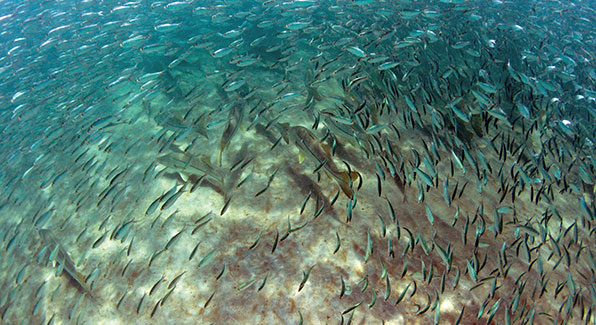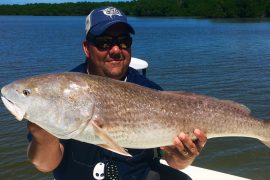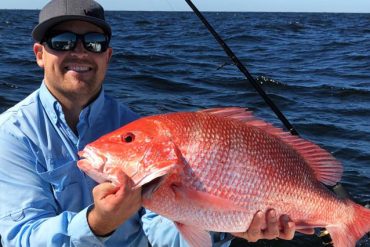The Future Looks Bright for Florida’s Forage Fish
Florida is widely considered the Fishing Capital of the World, and for good reason. No other state can boast the number of days fished by anglers, revenue generated and the many International Game Fish Association records held. Florida also supports a vibrant commercial fishing industry that provides high-valued species such as grouper and snapper from both the Atlantic and Gulf coasts. Taken collectively, Florida’s recreational and commercial fisheries account for an astounding $12 billion each year in revenue and over 100,000 jobs.

The health of Florida’s fisheries rests upon the shoulders of the Florida Fish and Wildlife Conservation Commission. In order to maintain sustainable fisheries, the FWC employs a suite of traditional fisheries management tools such as bag limits, size limits and closed seasons to ensure that commercial and recreational fisheries don’t become depleted. This becomes an increasingly tall order when you consider the exponential population growth the state is experiencing coupled with the thriving popularity of recreational fishing statewide.
…Florida’s recreational and commercial fisheries account for over $12 billion each year in revenue and over 100,000 jobs.
But there are additional factors that also have a significant impact on the health of fisheries such as prey abundance. It’s a simple concept and one well known to anglers worldwide: big fish eat small fish to grow and reproduce. These small fish, or forage fish as they are often referred to, are a critical link in marine ecosystems. They feed on small plant and animal matter and, in turn, transfer their energy up the food chain to larger predators.
Most forage fish species are small, reproduce at an early age and are not long-lived. They also have a tendency to congregate in large schools for safety—making them relatively easy to exploit. And while they are ubiquitous and abundant, they are also prone to natural fluctuations in population size from changes in environmental conditions. Reproduction at an early age is a life-history strategy that allows forage fish species to be resilient to changing environmental conditions. However, problems can occur when an excessive level of fishing pressure is added, leading forage fish stocks to eventual collapse.
Worldwide it is estimated that approximately 37-percent of the global fish harvest is forage fish. They are utilized for a variety of products including nutritional supplements, poultry and pet feed, and even cosmetics. And the global demand for forage fish appears to be increasing, which is cause for alarm because there are prior instances, both domestic and international, where forage fish stocks have been driven to complete collapse.
Luckily, in the last decade or so, fisheries scientists and managers have begun to investigate the true importance of forage fish to marine predators. One particular study investigated a number of marine ecosystems around the world and discovered that there is an extreme connection between forage fish and marine predators. So much so, that in 75-percent of ecosystems that were studied there was at least one predator with a forage fish diet of 50-percent or greater. This same study also valuated the economic worth of the global forage fish catch at $5.6 billion. However, considering the connection and importance of forage fish to commercially important predator fish, the supportive value of forage fish was estimated at over $11 billion. The take home message here is that it appears forage fish have a greater value when ample numbers are left in the water as food for predators.
Studies like these have caused fisheries managers around the country to readdress how forage fish are managed. Several federal fisheries councils have taken big steps to protect forage fish, especially those that aren’t currently managed, as have several state fisheries agencies. But, where does that leave Florida?
For the last year, a coalition of organizations including the International Game Fish Association, PEW Charitable Trusts, Florida Wildlife Federation and the Snook and Game Fish Foundation have been dialoging with commercial and recreational anglers about forage fish and their importance to Florida fisheries. The coalition also had a number of meetings with senior FWC staff that focused on the current status of forage fish and how they are managed in Florida, which ultimately led to the FWC adding forage fish management as an agenda item for its June meet-ing that was held in Sarasota.
During the meeting, FWC staff gave a presentation that discussed what forage fish are, their importance, as well as how they are being managed. Several forage fish species such as ballyhoo and mullet already have considerable regulations in place, which have resulted in healthy stocks for both species. FWC also collects data on unmanaged species that are analyzed and compiled in status and trend reports. According to FWC scientists, there are no significant issues right now with either managed or un-managed forage fish stocks—good news indeed for Florida fisheries.
As good as things currently look for forage fish in Florida, the FWC took an additional step by adopting a resolution to demonstrate their commitment to healthy forage fish stocks. The resolution highlights the importance of forage fish for Florida’s commercial and recreational fisheries. In it, the FWC commits itself to maintaining a management approach that will ensure an abundance and diversity of forage fish necessary to support marine ecosystems. FWC furthered its commitment to remain-ing vigilant regarding the status of forage fish through working with stakeholders to elevate the importance of forage fish and their management in Florida.
All in all, things look pretty good for Florida’s forage fish. Sure, there are areas around the state experiencing habitat is-sues that are impacting both forage and predatory fish species. However, from a fisheries management perspective, it looks like FWC’s doing a pretty good job of monitoring forage fish and taking the appropriate steps to ensure that significant declines don’t occur. Here’s to many more years of greatness.
The Future Looks Bright for Florida’s Forage Fish
Florida is widely considered the Fishing Capital of the World, and for good reason. No other state can boast the number of days fished by anglers, revenue generated and the many International Game Fish Association records held. Florida also supports a vibrant commercial fishing industry that provides high-valued species such as grouper and snapper from both the Atlantic and Gulf coasts. Taken collectively, Florida’s recreational and commercial fisheries account for an astounding $12 billion each year in revenue and over 100,000 jobs.

The health of Florida’s fisheries rests upon the shoulders of the Florida Fish and Wildlife Conservation Commission. In order to maintain sustainable fisheries, the FWC employs a suite of traditional fisheries management tools such as bag limits, size limits and closed seasons to ensure that commercial and recreational fisheries don’t become depleted. This becomes an increasingly tall order when you consider the exponential population growth the state is experiencing coupled with the thriving popularity of recreational fishing statewide.
…Florida’s recreational and commercial fisheries account for over $12 billion each year in revenue and over 100,000 jobs.
But there…





